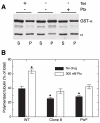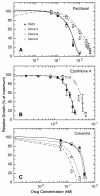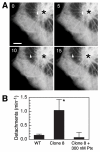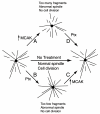Overexpression of mitotic centromere-associated Kinesin stimulates microtubule detachment and confers resistance to paclitaxel
- PMID: 21471284
- PMCID: PMC3112244
- DOI: 10.1158/1535-7163.MCT-10-1109
Overexpression of mitotic centromere-associated Kinesin stimulates microtubule detachment and confers resistance to paclitaxel
Abstract
Numerous studies have implicated mutations in tubulin or the overexpression of specific tubulin genes in resistance to microtubule-targeted drugs. Much less is known about the role of accessory proteins that modulate microtubule behavior in the genesis of drug resistance. Here, we examine mitotic centromere-associated kinesin (MCAK), a member of the kinesin family of microtubule motor proteins that has the ability to stimulate microtubule depolymerization, and show that overexpressing the protein confers resistance to paclitaxel and epothilone A, but increases sensitivity to colcemid. Cells transfected with FLAG-tagged MCAK cDNA using a tet-off-regulated expression system had a disrupted microtubule cytoskeleton and were able to survive a toxic concentration of paclitaxel in the absence, but not in the presence of tetracycline, showing that drug resistance was caused by ectopic MCAK production. Moreover, a population that was heterogeneous with respect to FLAG-MCAK expression became enriched with cells that produced the ectopic protein when it was placed under paclitaxel selection. Similar to previously isolated mutants with altered tubulin, paclitaxel resistant cells resulting from MCAK overexpression were found to have decreased microtubule polymer and a seven-fold increase in the frequency of microtubule detachment from centrosomes. These data are consistent with a model for paclitaxel resistance that is based on stability of the attachment of microtubules to their nucleating centers, and they implicate MCAK in the mechanism of microtubule detachment.
Figures







Similar articles
-
Mitotic centromere-associated kinesin (MCAK): a potential cancer drug target.Oncotarget. 2011 Dec;2(12):935-47. doi: 10.18632/oncotarget.416. Oncotarget. 2011. PMID: 22249213 Free PMC article. Review.
-
Mitotic centromere-associated kinesin (MCAK) mediates paclitaxel resistance.J Biol Chem. 2011 Oct 21;286(42):36378-84. doi: 10.1074/jbc.M111.296483. Epub 2011 Sep 7. J Biol Chem. 2011. PMID: 21903575 Free PMC article.
-
Amino acid substitutions at proline 220 of beta-tubulin confer resistance to paclitaxel and colcemid.Mol Cancer Ther. 2007 Oct;6(10):2798-806. doi: 10.1158/1535-7163.MCT-06-0791. Mol Cancer Ther. 2007. PMID: 17938271
-
Detection and quantification of microtubule detachment from centrosomes and spindle poles.Methods Cell Biol. 2013;115:49-62. doi: 10.1016/B978-0-12-407757-7.00004-9. Methods Cell Biol. 2013. PMID: 23973065
-
Microtubules and resistance to tubulin-binding agents.Nat Rev Cancer. 2010 Mar;10(3):194-204. doi: 10.1038/nrc2803. Epub 2010 Feb 11. Nat Rev Cancer. 2010. PMID: 20147901 Review.
Cited by
-
Microtubule-Binding Proteins as Promising Biomarkers of Paclitaxel Sensitivity in Cancer Chemotherapy.Med Res Rev. 2016 Mar;36(2):300-12. doi: 10.1002/med.21378. Epub 2015 Sep 1. Med Res Rev. 2016. PMID: 26332739 Free PMC article. Review.
-
Oncogenic role of kinesin proteins and targeting kinesin therapy.Cancer Sci. 2013 Jun;104(6):651-6. doi: 10.1111/cas.12138. Epub 2013 Apr 4. Cancer Sci. 2013. PMID: 23438337 Free PMC article. Review.
-
Role of the Number of Microtubules in Chromosome Segregation during Cell Division.PLoS One. 2015 Oct 27;10(10):e0141305. doi: 10.1371/journal.pone.0141305. eCollection 2015. PLoS One. 2015. PMID: 26506005 Free PMC article.
-
Overexpression of forkhead box protein M1 (FOXM1) in ovarian cancer correlates with poor patient survival and contributes to paclitaxel resistance.PLoS One. 2014 Nov 20;9(11):e113478. doi: 10.1371/journal.pone.0113478. eCollection 2014. PLoS One. 2014. PMID: 25411964 Free PMC article.
-
Mitotic centromere-associated kinesin (MCAK): a potential cancer drug target.Oncotarget. 2011 Dec;2(12):935-47. doi: 10.18632/oncotarget.416. Oncotarget. 2011. PMID: 22249213 Free PMC article. Review.
References
-
- Cabral F. Factors determining cellular mechanisms of resistance to antimitotic drugs. Drug Resistance Updates. 2001;3:1–6. - PubMed
-
- Helenius J, Brouhard G, Kalaidzidis Y, Diez S, Howard J. The depolymerizing kinesin MCAK uses lattice diffusion to rapidly target microtubule ends. Nature. 2006;441:115–9. - PubMed
-
- Ogawa T, Nitta R, Okada Y, Hirokawa N. A common mechanism for microtubule destabilizers-M type kinesins stabilize curling of the protofilament using the class-specific neck and loops. Cell. 2004;116:591–602. - PubMed
Publication types
MeSH terms
Substances
Grants and funding
LinkOut - more resources
Full Text Sources
Research Materials

